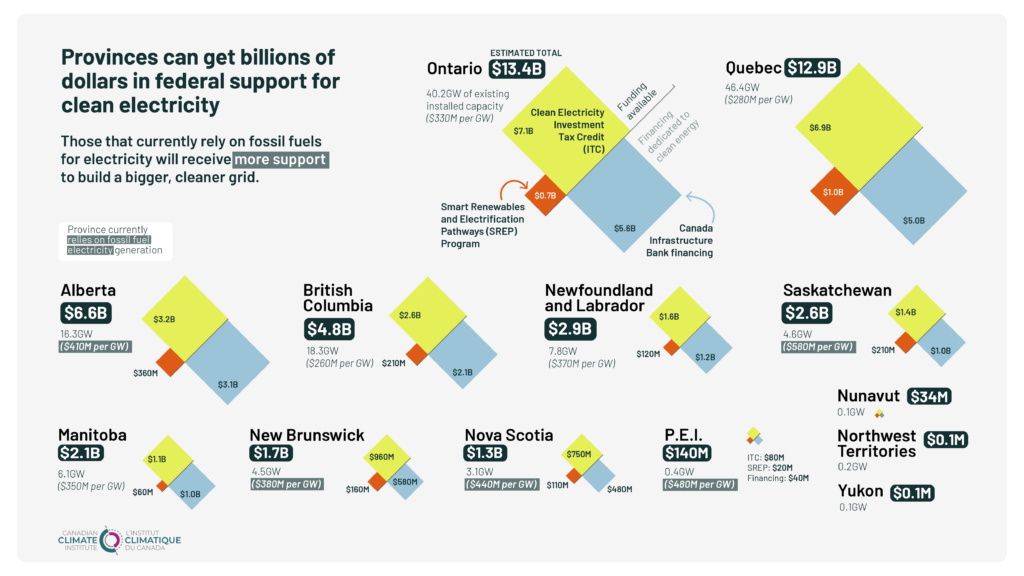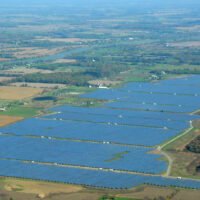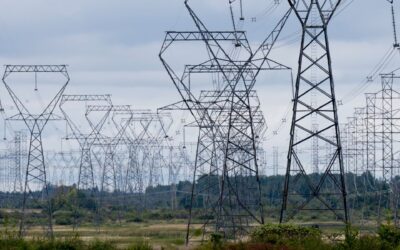Initially published in Policy Options.
Clean electricity will power Canada’s future economy. In its 2023 budget, the federal government made a historic commitment to support the build-out of the bigger, cleaner, smarter grids required to meet Canada’s climate targets and unlock an affordable energy future.New analysis from the Canadian Climate Institute estimates how much provinces and territories could gain from these supports for electricity system upgrades (figure 1).

It’s a lot: the Clean Electricity Investment Tax Credit has an estimated value of $25.7 billion. The government has signaled that these credits would be conditional on certain provincial actions, and it plans to consult on these conditions in the coming months.
What kinds of conditions make sense?
Research from the Climate Institute found the federal government can create institutional incentives to help provinces accelerate the transformation of their electricity systems. It can do so without intruding on provincial jurisdiction by placing four specific conditions on provincial eligibility for federal investment tax credits and other supports.
Condition 1: Commissioning independent pathway assessments
A first condition that can support effective and cost-effective provincial energy transitions is requiring provinces to commit to commissioning periodic independent pathway assessments. Such assessments would take a whole-economy perspective, and focus on the options provinces have to meet their own energy needs in ways consistent with net-zero emissions.
Pathway assessments would provide credible clarity on the available paths forward for a given province or territory, acting as a common resource to inform decision-making from governments, utilities, system operators, and regulators. To ensure the assessments effectively maintain this role, they would be periodically updated (perhaps every three to five years) to reflect changing market conditions, technological possibilities, and cost profiles.
Condition 2: Updating the mandates of public institutions
Provinces would commit to updating the mandate of electricity system operators, public utilities and provincial utility regulators to include the attainment of net-zero goals. In most cases, these bodies were formed well before climate change was an understood problem, so how their mandates relate to climate change is often unstated or ambiguous. Across the country, these institutions’ existing mandates are driving inertia – even when governments have clear climate plans and targets.
The updates required under this condition would be an extension, rather than a redesign, of existing mandates (which usually involve providing safe and reliable power at just and reasonable rates). This kind of mandate clarification, which the U.K. is now moving to provide, would allow these bodies to understand that their job is to ensure climate goals get met in ways that are in the interest of ratepayers.
Condition 3: Developing a net-zero energy vision
Updating mandates to align with net-zero goals is a necessary but insufficient condition for accelerating provincial electricity system transformation. There are simply too many possible pathways to net zero for utility regulators to have a defensible basis for their decisions, and these bodies are not in the business of policymaking.
An energy vision is a document that provides regulators and other actors with signposts for a province’s energy transition, and guides their implementation and oversight of it. Such vision documents would be produced by provincial and territorial governments, setting out their vision on which pathways to net zero the province plans to walk – or avoid. While these vision documents would be non-binding and high-level, they would provide clear direction from government while leaving the details of how to deliver on the government’s vision to the expert bodies charged with operation and oversight of electricity systems.
Condition 4: Participating in information exchange
The fourth and final condition would require provinces to participate in forums where they would share experience and data and have the opportunity to collaborate on shared challenges. While the findings, best practices, or recommendations that emerge from these forums would be non-binding on the provincial governments and public institutions that participate in them, they would nevertheless help break down some of the silos that exist across provincial systems.
Encouraging provincial action while not overstepping
Under this model, financial support from the federal government would be secured through agreements negotiated between individual provinces and the federal government. Provinces would have a direct financial incentive to agree to the conditions outlined above because of the significant potential for defraying system investment costs – which would benefit their ratepayers.
The federal government, for its part, would have a way of driving meaningful policy change at the provincial level. (The federal government could also strengthen the incentive provinces have to sign on by offering not only access to the Clean Electricity Investment Tax Credit under the agreements, but also the Canadian Infrastructure Bank financing and funds from the Smart Renewables and Electrification Pathways Program seen in figure 1.)
Critically, the conditions specified in the agreements would respect provincial jurisdiction over electricity by leaving provinces with full discretion over the details of how they are implemented. For example, the content of provinces’ net-zero energy visions would be entirely at their discretion. In this way, the conditions represent a relatively nonprescriptive way for the federal government to enable and accelerate the transformation of provincial and territorial systems and build the 21st-century energy infrastructure Canadians need.








